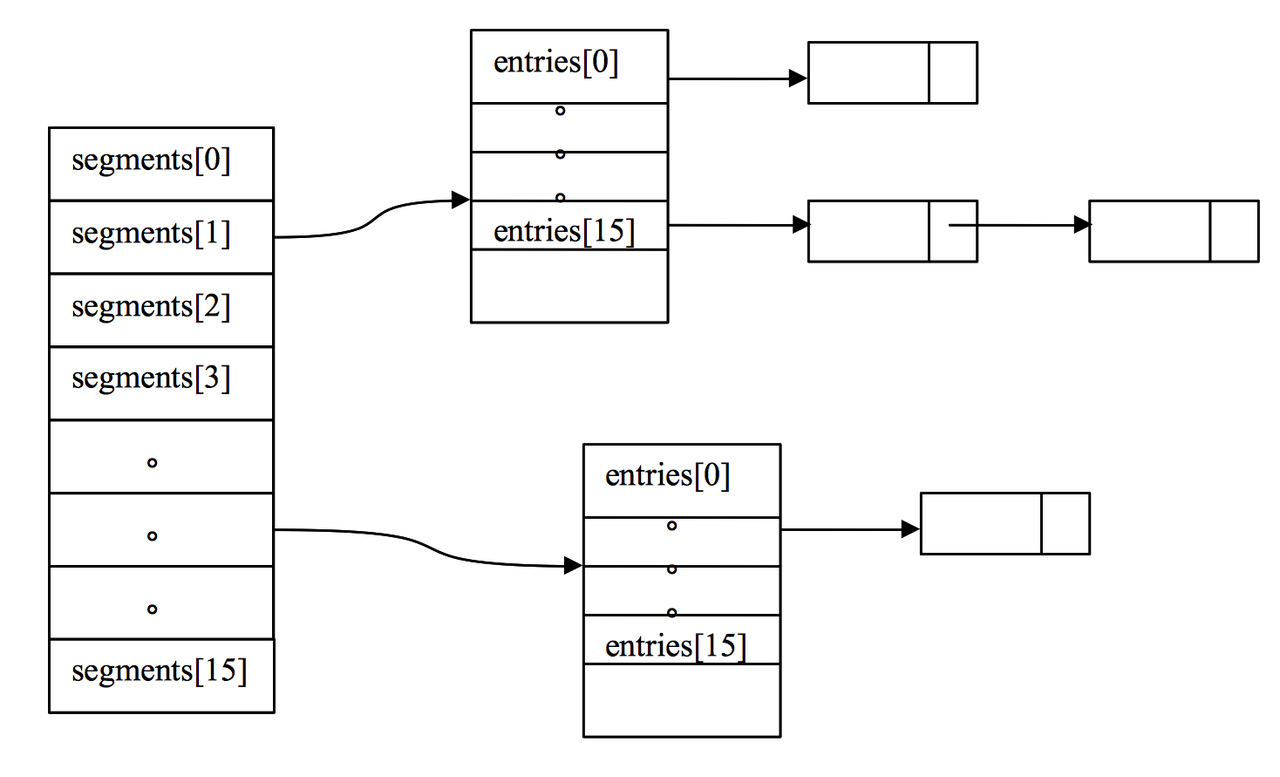Java-ConcurrentProgramming-CheatSheet
Java Concurrent Programming CheatSheet
当出现线程活跃性问题时,我们可以借助一些工具进行诊断:
-
Jstack。通过 jstack 命令,获取线程执行信息,找出其中的线程阻塞和死锁问题。
-
Heap dump。通过 jmap 命令 dump 出当前的 jvm 堆栈信息,然后使用内存分析工具识别线程阻塞和死锁。
-
Arthas。作为阿里开源的 Java 诊断利器,arthas 也提供了线程分析诊断功能, 可以通过 arthas 的 thread 命令,查找出当前阻塞的线程。
java.util.concurrent 包提供了一系列的并发工具类,让我们能够站在巨人的肩膀上,更加高效地实现并发程序。需要注意的是,我们一定要在正确地理解了当前所要处理的并发问题,以及工具类的机制原理之后,再去选择相应的并发工具类。如果只是一知半解就去盲目使用,很可能会给自己挖坑。
Concurrent Primitive | 并发单元
常见的 Runnable、Callable、Future、FutureTask 这几个与线程相关的类或者接口:
-
Runnable 应该是我们最熟悉的接口,它只有一个 run()函数,用于将耗时操作写在其中,该函数没有返回值。然后使用某个线程去执行该 runnable 即可实现多线程,Thread 类在调用 start()函数后就是执行的是 Runnable 的 run()函数。
-
Callable 与 Runnable 的功能大致相似,Callable 中有一个 call()函数,但是 call()函数有返回值,而 Runnable 的 run()函数不能将结果返回给客户程序。
-
Executor 就是 Runnable 和 Callable 的调度容器,Future 就是对于具体的 Runnable 或者 Callable 任务的执行结果进行取消、查询是否完成、获取结果、设置结果操作。get 方法会阻塞,直到任务返回结果。
-
FutureTask 则是一个 RunnableFuture
,而 RunnableFuture 实现了 Runnbale 又实现了 Futrue 这两个接口。
Threads & Runnables
Thread Pool | 线程池
Executors
在并发程序中,线程的创建和管理是一个重要的命题。实际的生产代码中,不能为每一个任务就创建一个线程,也就是不能出现 new Thread(runnable).start()这样的代码,因为线程是昂贵的系统资源,不能无节制地创建,需要使用线程池对线程进行管理。Excutor 类支持了线程资源的管理和多线程任务的调度。可以使用 Executors 中的静态方法之一来创建一种线程池(newFixedThreadPool、newCachedThreadPool、newSingleThreadPool、newScheduledThreadPool 等),可以使用 Runalbe、Callable 来提交并发任务,Excutor 类会自己负责任务的调度,解耦了任务的提交和执行。
Callable<Integer> task = () -> {
try {
TimeUnit.SECONDS.sleep(1);
return 123;
}
catch (InterruptedException e) {
throw new IllegalStateException("task interrupted", e);
}
};
ExecutorService executor = Executors.newFixedThreadPool(1);
Future<Integer> future = executor.submit(task);
System.out.println("future done? " + future.isDone());
Integer result = future.get();
System.out.println("future done? " + future.isDone());
System.out.print("result: " + result);
在使用 Excutor 时,如果线程池的任务之间存在依赖,线程池中的某些任务需要无限期地等待一些其它任务提供的资源;或者某些任务运行耗时较长,其它任务得不到运行资源,则会出现线程饥饿,引发活跃性问题,需要避免。
Fork/Join
线程协作
Atomic Variables | 原子性与原子变量
从 Java5.0 开始,提供了一组原子类变量(例如 AtomicInteger,AtomicLong,AtomicBoolean,AtomicReference 等),来支持对单个变量的原子性操作。内置的监视器锁,是一种悲观锁,任何时候只有一个线程可以持有该锁,其它想获取该锁的线程必须阻塞等待。而 Atomic 类提供了一种乐观机制,任何线程都可以尝试获取资源并更新,如果在更新的过程中存在来自其它线程的干扰,那么这个操作将失败并可以重试。
Atomic 的实现依赖于处理器提供的 CAS(Compare and Swap)指令。CAS 是一个原子性操作,包含三个操作数:需要读写的内存位置 V、旧值 A 和拟写入的新值 B。线程读取 V 的值,如果等于 A,则将 V 的值更新为 B,返回成功,否则返回失败。
@ThreadSafe
public class SafeSequence {
private AtomicInteger value;
/**
* Returns a unique value.
*/
public int getNext() {
return value.getAndIncrement();
}
}
相对于内置的监视器锁,Atomic 更加地轻量和高效,不存在死锁和活跃性问题。其主要劣势在于,需要调用者来处理竞争问题,决定在 CAS 操作失败时是重试、回退还是放弃。
volatile | 可见性保障
CountDownLatch
CountDownLatch 可以用来保证某些活动直到其它活动都完成之后才继续执行。
public class TestHarness {
public long timeTasks(int nThreads, final Runnable task)
throws InterruptedException {
final CountDownLatch startGate = new CountDownLatch(1);
final CountDownLatch endGate = new CountDownLatch(nThreads);
for (int i = 0; i < nThreads; i++) {
Thread t = new Thread() {
public void run() {
try {
startGate.await();
try {
task.run();
} finally {
endGate.countDown();
}
} catch (InterruptedException ignored) {
}
}
};
t.start();
}
long start = System.nanoTime();
startGate.countDown();
endGate.await();
long end = System.nanoTime();
return end - start;
}
锁与互斥
Semaphore
信号量 Semaphore,用来控制同时访问某个特定资源的操作数量。Semaphore 中管理着一组虚拟许可,如果没有许可,则 acquire 操作将阻塞直到有许可。可以把锁看做一种特殊的二元信号量。
public class BoundedHashSet<T> {
private final Set<T> set;
private final Semaphore sem;
public BoundedHashSet(int bound) {
this.set = Collections.synchronizedSet(new HashSet<T>());
sem = new Semaphore(bound);
}
public boolean add(T o) throws InterruptedException {
sem.acquire();
boolean wasAdded = false;
try {
wasAdded = set.add(o);
return wasAdded;
} finally {
if (!wasAdded) sem.release();
}
}
public boolean remove(Object o) {
boolean wasRemoved = set.remove(o);
if (wasRemoved) sem.release();
return wasRemoved;
}
}
Lock
Lock 类提供了一种可轮询的、定时的以及可中断的锁获取操作,当内置锁无法满足使用场景的要求时,可以考虑使用显式的 Lock。举一个带有时间限制的 Lock 示例:
public class TimedLocking {
private Lock lock = new ReentrantLock();
public boolean trySendOnSharedLine(
String message,
long timeout,
TimeUnit unit
)
throws InterruptedException {
long nanosToLock = unit.toNanos(timeout) - estimatedNanosToSend(message);
if (!lock.tryLock(nanosToLock, NANOSECONDS)) return false;
try {
return sendOnSharedLine(message);
} finally {
lock.unlock();
}
}
}
Async Programming | 异步编程
Callable & Future
CompletableFuture
RxJava
Built-in ThreadSafe DataStructure | 内置的线程安全模型
ConcurrentHashMap
为了解决线程活跃性问题,提高并发执行效率,一种可行的方案是降低锁的粒度。ConcurrentHashMap 可以看作这种思路的优秀实践,内部使用了分段锁(Lock Striping)的方式来降低锁的粒度,使用一个包含 16 个锁的数组,每个锁保护所有哈希桶的 1/16,其中第 N 个哈希桶,由 N%16 个锁来维护。其原理如下图所示:

